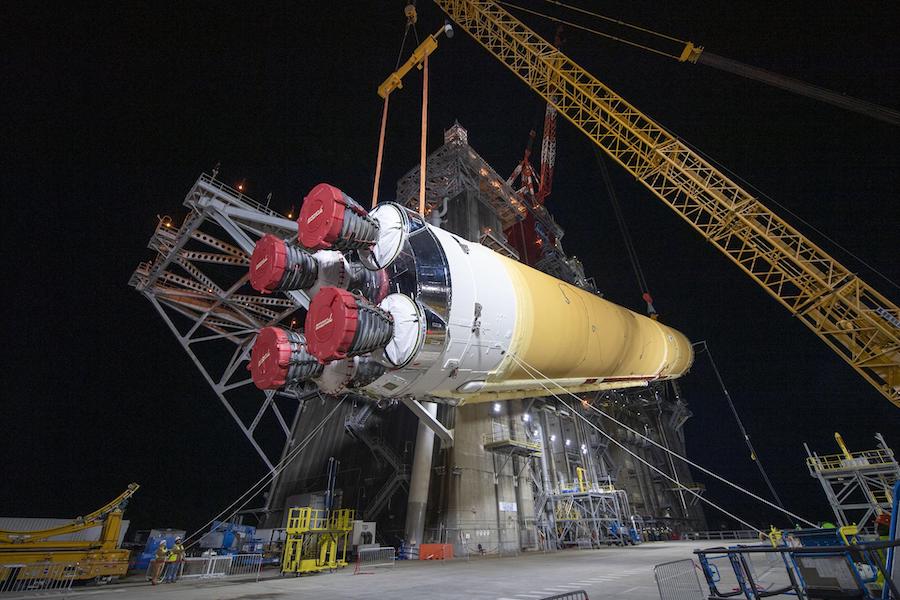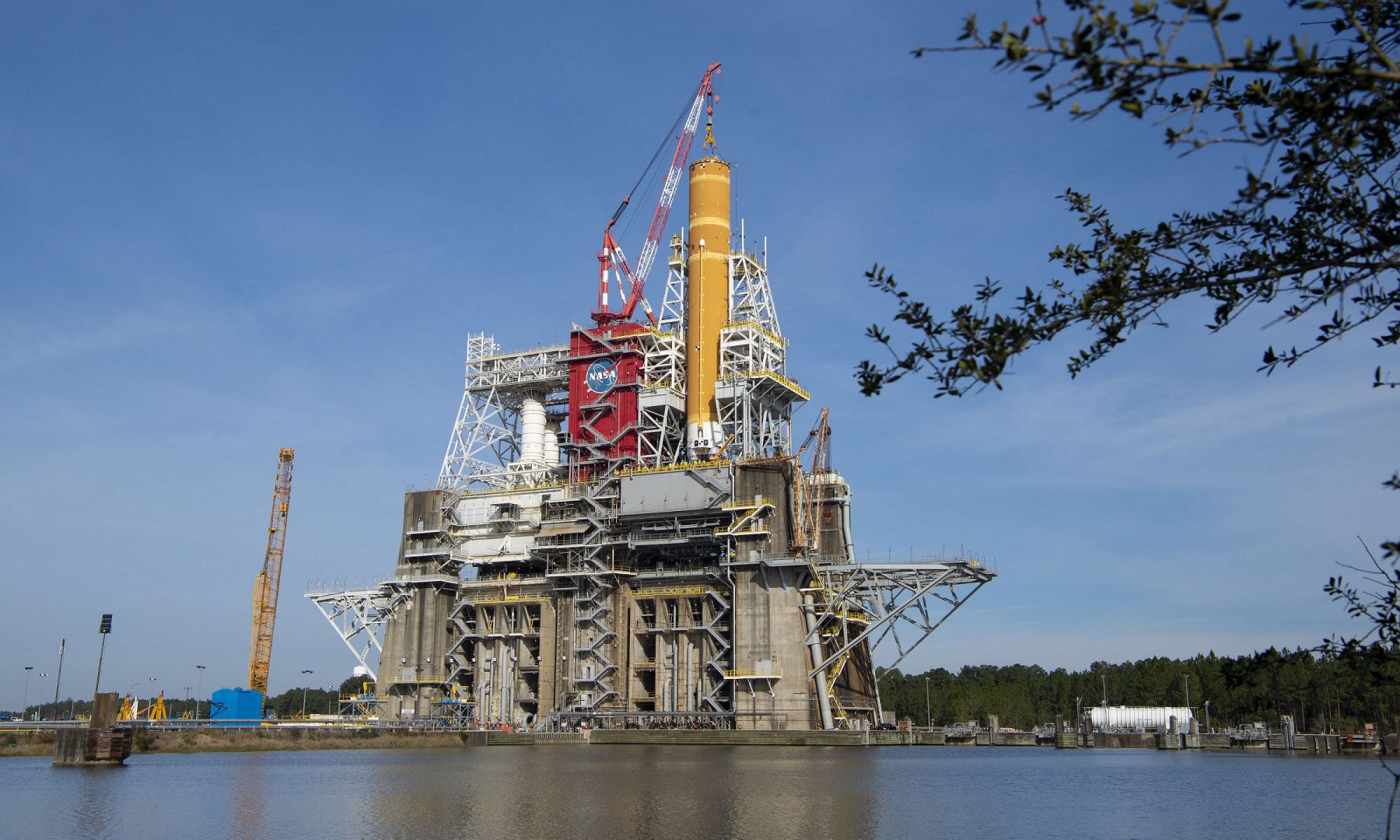With the passage of the NASA Authorization Act of 2010, work began on a launch vehicle that would carry cargo and crews back to the Moon and beyond. This vehicle is known as the Space Launch System (SLS), a heavy-launch system that (once fully operational) will be the most powerful rocket in the world since the Saturn V – the venerable vehicle that took the Apollo astronauts to the Moon.
Unfortunately, the development of the SLS has suffered from multiple delays over the past few years, causing no shortage of complications. However, engineering teams at NASA’s Stennis Space Center near St. Louis, Mississippi, recently completed a Green Run of the SLS’s Core Stage, which involved testing the rocket’s critical systems in preparation for its inaugural launch by November of 2021.
A Green Run refers collectively to a full range of tests and functional checks designed to validate the flight hardware of a system. This began back in January when engineers started activating and testing the core stage’s components one by one to identify any possible issues. This will culminate with a test firing of the core stage’s RS-25 engines, which will replicate the SLS’s first launch.

As Richard Sheppard, the SLS Stages Green Run Test Lead from NASA’s Marshall Space Flight Center, said in a NASA press release:
“Green Run is the step-by-step testing and analysis of the new SLS rocket core stage that will send astronauts to the Moon. This testing will reduce risks for, not only the first flight, but also for the Artemis mission that will land astronauts on the Moon in 2024.”
These tests, which are taking place at the B-2 Test Stand at NASA’s Stennis Space Center, were temporarily suspended on March 18th as the Center went to Stage 4 on the Agency Response Framework (in response to a rise in COVID-19 cases in the area near the Stennis Space Center). Other centers involved in the construction of the SLS – NASA’s Marshall Space Flight Center and its Michoud Assembly Facility – were also closed.
At the time, engineers at Stennis had just completed the first of eight tests in the Green Run series – known as the Modal Test. This consists of applying external forces to the core stage in order to simulate launch conditions and measure how the vehicle handles the intense vibrations. Around mid-May, the Center reopened and engineers slowly and methodically resumed their battery of tests and checks.

Ryan McKibben, a Green Run test conductor at Stennis, indicated what the next phase will entail:
“The team connected the facility with the rocket earlier this year, both electrically and mechanically. We are now preparing for the second test, which will power on the vehicle’s avionics and the three computers that control the rocket’s flight as it soars into space.”
These avionics include flight computers, cameras, batteries, power and data handling, sensors, and other electronics that are distributed throughout the core stage. For this stage of the Green Run, engineers at NASA’s Marshall Space Flight Center have designed software similar to what the SLS will use for actual launches. Meanwhile, a special stage controller will be used as an operations center, simulating what missions control does for real launches.
“The core stage avionics along with Green Run software have successfully completed tests in our test laboratories at Marshall,” added Lisa Espy, the core stage avionics lead at Marshall. “I am excited to see the flight systems come to life that will control the rocket as it sends the first Artemis mission to the Moon.”

Over the course of the next year, engineers will conduct the Fail-Safes test, which shut down operations during a launch; the Propulsion test, where each component of that connects to the engines will be operated to check for gas or fluid leaks; the Thrust Vector Controls test, where the systems that allow the four engines to adjust will be tested; and the Countdown test, where all systems will be powered up for a simulated countdown.
If all goes to plan, this will be followed by the “Wet” Dress Rehearsal, where the Core Stage will be fully-loaded with over 2.65 million liters (700,000 gallons) of cryogenic propellants. The eighth and final stage, the Hot Fire, will see the four RS-25 engines ignited and firing for up to 8 minutes, generating 725 metric tons (800 US tons; 1.6 million lbs) – the same amount the engines produce during liftoff at sea level.
With the completion of all tests associated with the Green Run, engineers will refurbish the core stage and configure it for its journey to the Kennedy Space Center. Once there, it will undergo preparations for launch as the first mission of Project Artemis – Artemis I, formerly known as Exploration Mission-1 (EM-1) – which will send an uncrewed Orion capsule around the Moon to test its systems in preparation for a crewed launch to the Moon.
Prior to the closures caused by the COVID-19 outbreak, NASA hoped to conduct this launch by February of 2021. Unfortunately, the closures and delays that resulted meant that this timeline had to be pushed a full nine months back to November. However, it was evident even before the outbreak that the inaugural launch was not likely to happen until sometime next year.
Nevertheless, NASA is still committed to making the long-awaited return to the Moon by 2024 with the Artemis III mission. In between, they hope to conduct the first crewed flight of the Orion (Artemis II) in 2023, which could include a rendezvous demonstration with another spacecraft while in orbit around Earth.
This test will evaluate the Orion‘s ability to rendezvous with the Lunar Lander that NASA recently contracted with three commercial space launch providers to develop. It will also test the spacecraft’s ability to rendezvous with the nucleus of the mini-space station version of the Lunar Gateway, the latter of which NASA hopes to deploy by the mid-2020s using the Falcon Heavy (or another commercial launch vehicle).
NASA’s plans for returning to the Moon have gone through a number of revisions and shakeups in the past few years. But as these preparations (and the recent release of the Artemis Accords) demonstrate, they are committed to making it happen and ensuring that there is a sustainable human presence on the Moon by the end of this decade.
Further Reading: NASA, ArsTechnica

